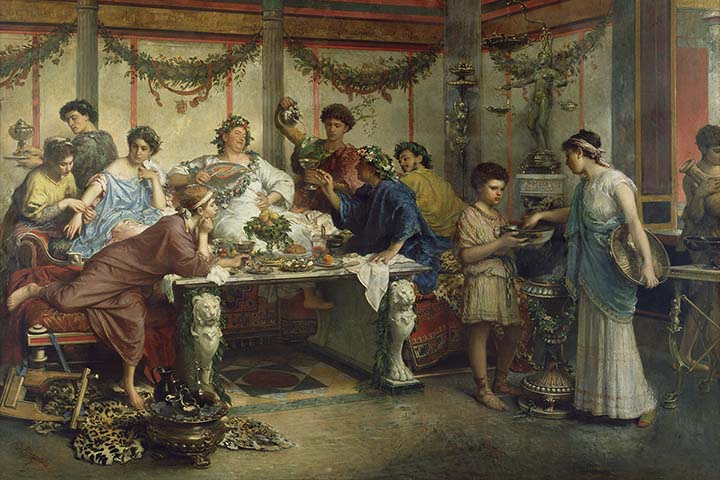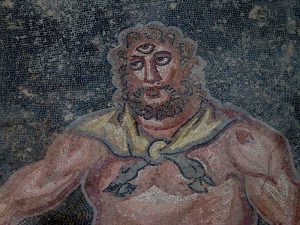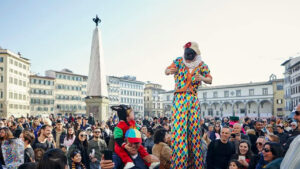DEATH AND MEMORY IN ROME AT “TRIMALCHIO’S DINNER”
5 min read
The so-called “Trimalchio’s dinner” is the longest surviving section of the Satyricon (that literally means “satyric tales”) that is a Latin literature novel written by Petronius around the middle of the 1st century a.D., during the reign of emperor Nero (54-68 a.D.). “Trimalchio’s dinner” is part of the fifteenth book of the work, which is the only one to have been preserved entirely. And, this dinner shows the participation of the three main characters of the story, Encolpius, Giton and Ascyltos in the rich banquet offered by the freedman Trimalchio, who was a former slave enriched thanks to trade.
The banquet consists in a succession of separate sketches, in which the rhetorical speeches of the host and his guests alternate with scandalous tales, dances, circus shows and sexual encounters. Among these, the one in which Trimalchio, turning to the marble worker Habinna, gives a very detailed description of his funerary monument is considered of great interest:
Trimalchio turned to Habinnas. «You’re my best buddy, you know? So are you building my tomb the way I ordered? At the base of my statue you’ve gotta paint a puppy and garlands and bottles of perfume and all the fights of Petraites. It’ll feel like I’m still alive, and I’ll owe it all to you […] Lots of fruit trees all over and plenty of grapevines, okay? […] Do a ship sailing with the sails full of wind, […] Do some dining rooms, too, […] Put Fortunata on my right, and have her holding a dove. […] In the middle put a sundial, so that anybody who wants to know the time has to look at my name. And see what you think of this inscription: “Here lies Gaius Pompeius Trimalchio, Freedman of Maecenas. He was elected sevir, […] he was brave, faithful, and he started small and made it big. He left a fortune of thirty million sesterces. He never in his life paid any attention to a philosopher. Farewell to him. And to you, stranger”».
(Translated by Sarah Ruden, Part 3 pp. 54-55)
The extraordinary importance of this passage is due to the extremely realistic picture that Petronius, through Trimalchio’s monologue, gives of the relationship between the society of his time and death; and moreover, this is a picture whose historicity is confirmed in the epigraphs and funerary monuments scattered throughout the territory of the Roman Empire.
The figurative decorations and inscriptions that compose the freedman’s tomb, above all, aim at the reconstruction of his biography. To this end, in particular, the following contribute:
- the images of the deceased and his loved ones, such as his portrait sculpture, that of his wife Fortunata and the depiction of his beloved puppy;
- the reference to his profession, which is linked to the representation of “ship sailing with the sails full of wind”, that is the emblem of the commerce practiced by him;
- the reference to the political career, which in the epitaph (that is the sepulchral inscription) focuses on the granting of the magistracy of the sevirate;
- Finally, the memory of his sporting passion, which is evident from the request to paint the fights of Petraites who was a famous gladiator of the Neronian era.
Then, of great interest are the expedients aimed at convincing the traveler to stop at the monument, so that he can read its contents. In the speech of Trimalchio we identify:
- the practice of creating a space used as a garden in the burial area, adorned with “Lots of fruit trees all over and plenty of grapevines”, which had to induce the traveler to rest in the shade, which also contributes to the addition of “triclinia” (or benches);
- setting up a dialogue between the deceased and the passer-by, which was generally introduced by the explicit invitation to stop, proven by the goodbye greeting “Farewell to him” (in Latin: Vale) addressed from the deceased to the living person, who returns answering “And to you” (in Latin: Et tu).
However, the expedient to which Trimalchio gives the greatest importance is the placement, “in the middle”, of a clock (or sundial), “so that anybody who wants to know the time has to look at my name.” (in Latin: ut quisquis horas inspiciet, velit nolit, nomen meum legat).
With this statement, the freedman expresses all the obsession that the Romans felt for life after death. Actually, since they were deeply superstitious and not very linked to an otherworldly perspective, they believed that only by naming a person, and therefore, by evoking their memory, could they be rescued for a brief moment from eternal oblivion, bringing them back to life in the collective memory.
After all, this is the final aim of the funerary monument in its entirety, as we learn from the importance given by Trimalchio to Habinna’s work: “It’ll feel like I’m still alive, and I’ll owe it all to you” (in Latin: post mortem vivere). Here, then, that remaining sine titulo, sine nomine (“without inscription or name”), as Pliny the Younger remembers about Lucius Verginius Rufus (Letters 6.10), was considered a worse fate than death itself.
So, since they were convinced that bronze and marble were eternal, the Romans entrusted all their hope of surviving to inscriptions and funerary monuments. These stones of which Petronius, through the voice of Trimalchio, gives a wonderful literary testimony, told, actually, the story of people preserving their memory. Well, their memory, as this article proves, seems not to have been forgotten yet.
* cover image: Roberto Bompiani, A Roman Feast, late 19th century, Getty Museum (credits: flickr.com/photos/mharrsch/40089593493)

Mi chiamo Giulia. Diplomata al liceo classico, ho in seguito conseguito la laurea triennale in Interpretariato e Comunicazione e poi la laurea magistrale in Traduzione Specialistica. Ho lavorato sia come traduttrice per una piattaforma digitale sia come interprete di conferenza in sede di udienza. Ho da sempre avuto una forte propensione per le lingue straniere motivo per cui ho deciso di intraprendere questo percorso. Sono anche appassionata di cucina, cinema ma soprattutto di film e serie tv







